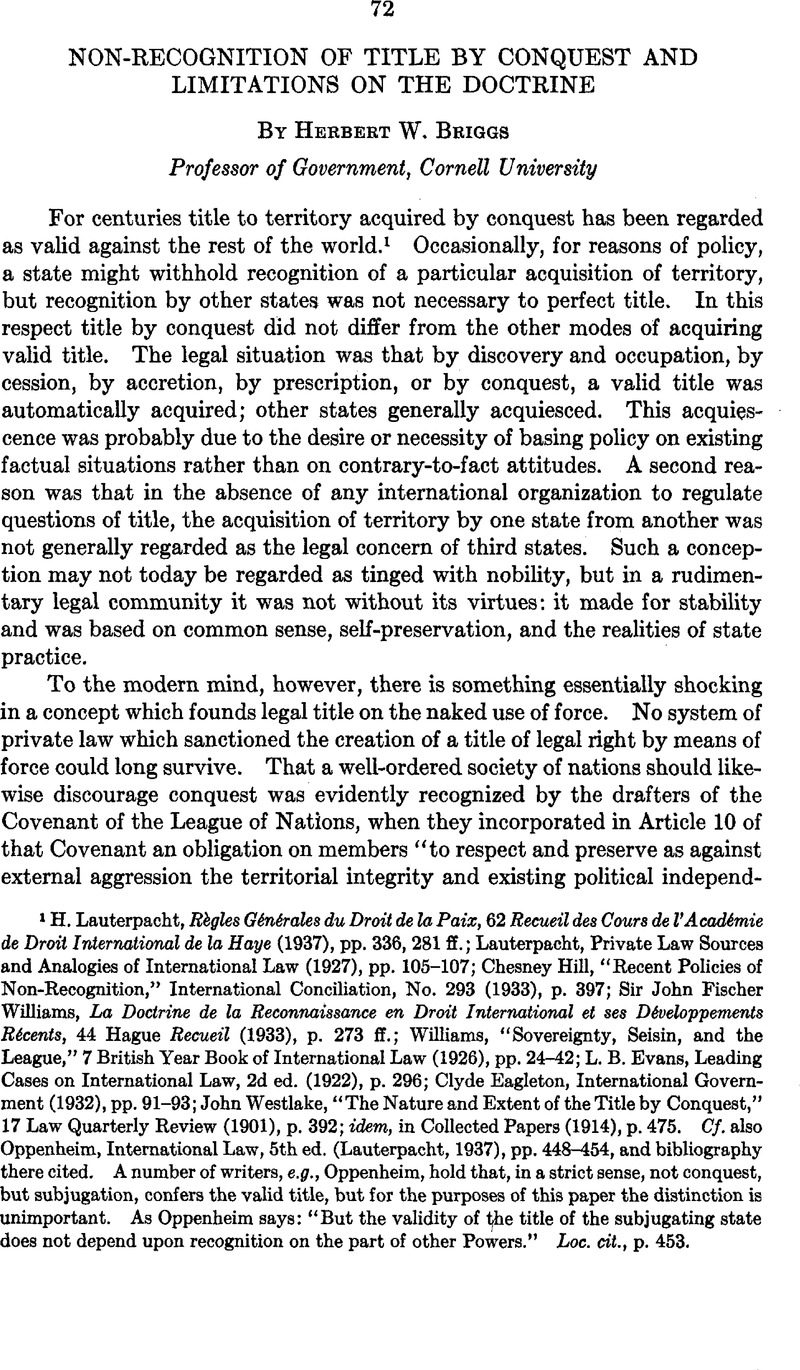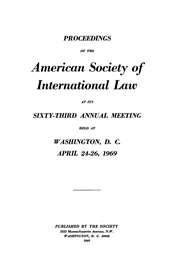Article contents
Non-Recognition of Title by Conquest and Limitations on the Doctrine
Published online by Cambridge University Press: 27 February 2017
Abstract

- Type
- Third Session
- Information
- Copyright
- Copyright © American Society of International Law 1940
References
1 Lauterpacht, H., Règies Générales du Droit de la Paix, 62 Recueil des Cours de l’Académie de Droit International de la Haye (1937), pp. 336 281 ff Google Scholar.; Lauterpacht, , Private Law Sources and Analogies of International Law (1927), pp. 105–107 Google Scholar; Hill, Chesney “Recent Policies of Non-Recognition,” International Conciliation 293 1933 397 Google Scholar; Fischer Williams, La Doctrine de la Reconnaissance en Droit International et ses Développements Récents 44 Hague Recueil 1933 273 ff.Google Scholar; Williams, “Sovereignty, Seisin, and the League,” 7 British Year Book of International Law 1926 24 42 Google Scholar; Evans, L. B. Leading Cases on International Law 2d ed. 1922 296 Google Scholar; Eagleton, Clyde International Government 1932 91 93 Google Scholar; Westlake, John “The Nature and Extent of the Title by Conquest,” 17 Law Quarterly Review 1901 392 Google Scholar; idem, in Collected Papers (1914), p. 475. Cf. also Oppenheim, International Law 5th ed. Lauterpacht 1937 448 454 Google ScholarPubMed, and bibliography there cited. A number of writers, e.g., Oppenheim, hold that, in a strict sense, not conquest, but subjugation, confers the valid title, but for the purposes of this paper the distinction is unimportant. As Oppenheim says: “But the validity of the title of the subjugating state does not depend upon recognition on the part of other Powers.” Loc. cit., p. 453.
2 Lauterpacht, 62 Hague Recueil 1937 293 Google Scholar.
3 Referring to the military operations between China and Japan in South Manchuria, Mr. Stimson notified those countries on January 7, 1932, that the United States: “can not admit the legality of any situation de facto nor does it intend to recognize any treaty or agreement entered into between those Governments, or agents thereof, which may impair the treaty rights of the United States or its citizens in China, including those which relate to the sovereignty, the independence, or the territorial and administrative integrity of the Republic of China, or to the international policy relative to China, commonly known as the open-door policy; and that it does not intend to recognize any situation, treaty, or agreement which may be brought about by means contrary to the covenants and obligations of the Pact of Paris of August 27,1928, to which treaty both China and Japan, as well as the United States are parties.” Department of State Press Releases, No. 119 (Jan. 9, 1932), pp. 41-42.
4 Letter from Stimson to Senator W. E. Borah, Feb. 23, 1932. Department of State Press Releases, No. 126 (Feb. 27, 1932), pp. 201, 205. See also Stimson, H. L. The Far Eastern Crisis 1936 165 175 Google Scholar.
5 Department of State Press Releases, No. 136 (May 7, 1932), p. 418.
6 Ibid., p. 446.
7 Department of State Press Releases, No. 136 (May 7, 1932), p. 419.
8 Ibid., p. 446.
9 Cf. Chesney Hill, loc. cit.; Lauterpacht, loc. cit.; Williams, loc. cit.; Williams, “The New Doctrine of Recognition,” 18 Transactions of the Grotius Society 1932 109 129 Google Scholar; Middlebush, F. A. “Non-Recognition as a Sanction of International Law,” Proceedings, American Society of International Law 1933 40 55 Google Scholar; McNair, A. D. “The Stimson Doctrine of Non-Recognition,” 14 British Year Book of International Law 1933 65 74 Google Scholar; Lawrence Lowell, A. “Manchuria, The League, and the United States,” 10 Foreign Affairs 1932 351 368 CrossRefGoogle Scholar; Willoughby, W. W. The Sino-Japanese Controversy and the League of Nations 1935 XX Google Scholar; Garner, J. W. “Non-Recognition of Illegal Territorial Annexations and Claims to Sovereignty,” 30 Am. Jour. Int. Law 1936 679 688 CrossRefGoogle Scholar; Wright, Quincy “The Stimson Note of January 7, 1932,” 26 ibid 1932 342 348 Google Scholar; idem, “Some Legal Aspects of the Far Eastern Situation,” 27 ibid 1933 509 516 Google Scholar; Moore, J. B. “Fifty Years of International Law,” 50 Harv. L. R. 1937 395, 434–436CrossRefGoogle Scholar.
10 Hyde, C. C. “Conquest Today,” 30 Am. Jour. Int. Law 1936 473 Google Scholar. Cf. Mr. Stimson’s story in his The Far Eastern Crisis, p. 162 ff., and the controversy on whether Sir John Simon refused to “go along” with Mr. Stimson, in Amerasia, Vol. III (1939), pp. 124 ff., 258–262.
11 League of Nations Official Journal 1932 Spec Supp 101 87 88 Google Scholar.
12 Dept. of State Press Releases, No. 149 (Aug. 6, 1932), pp. 100–101.
13 U. S. Treaty Series, No. 906.
14 Ibid., No. 881.
15 Lauterpacht, loc. cit., p. 286 ff.
16 See on this point, Sir John Fischer Williams in 44 Hague Recueil (1933), pp. 278–287; Lauterpacht, in 62 ibid. (1937), pp. 286, 336.
17 Lauterpacht, loc. cit., p. 293.
18 Am. Jour. Int. Law 33 1939 126 129 CrossRefGoogle Scholar. Cf. ibid., pp. 180–182, for the text of the “Chaco Arbitral Award delivered … by the Plenipotentiary Delegates Representing the Presidents of” the six republics. The circumstances of this particular arbitration appear to me to render academic the otherwise appropriate question of whether the arbitrators may be regarded as expressing their own views or the views of their governments. The Treaty of Peace, Friendship, and Boundaries of July 21, 1938, was signed not only by Bolivia and Paraguay but also by the six mediatory governments, and the preamble to the treaty states that the settlement was made “under the auspices and moral guarantee of the six mediatory Governments.” For an English translation of the treaty, see Department of State, Treaty Information Bulletin, No. 106 (July, 1938), pp. 256–258.
19 See also the Declaration of Non-Recognition of the Acquisition of Territory by Force approved Dec. 22, 1938, at the Eighth Pan American Conference at Lima (as reprinted in International Conciliation, No. 349 (1939), pp. 186–187):
“WHEREAS:
“The maintenance of peace and the preservation of the juridical order between the nations of America demand the adoption of a common and solidary attitude, already recognized by the Anti-War Treaty of Non-Aggression and Conciliation;
“It is necessary to define the scope of the continental doctrine of the non-recognition of the conquest or acquisition of territory by force;
“The geographical, historical and political conditions of the American nations preclude, on this continent, all territorial acquisitions by force; and
“It is desirable to coSrdinate, reiterate and strengthen the declarations and statements contained in the treaty of July 15, 1826, signed at the Congress of Panama; and in the treaties adopted at the Inter-American Congresses of Lima of 1847 and 1864; in the resolutions of April 18, 1890, approved at the First International Conference of American States; in the resolutions of February 18, 1928, adopted at the Sixth International Conference of American States; in the declaration of August 3, 1932, signed at Washington; in the Anti War Pact signed at Rio de Janeiro on October 10, 1933; in the Convention on Rights and Duties of States, signed at Montevideo on December 26,1933, at the Seventh International Conference of American States; and in the instruments approved on December 23,1936, at the Inter-American Conference for the Maintenance of Peace, held at Buenos Aires,
“The Eighth International Conference of American States
DECLARES:
“That it reiterates, as a fundamental principle of the Public Law of America, that the occupation or acquisition of territory or any other modification or territorial or boundary arrangement obtained through conquest by force or by non-pacific means shall not be valid or have legal effect.
“The pledge of non-recognition of situations arising from the foregoing conditions is an obligation which cannot be avoided either unilaterally or collectively.”
20 Am. Jour. Int. Law 30 1936 475 Google Scholar.
21 Cf. John Bassett Moore, “Candor and Common Sense,” an address before the Association of the Bar of the City of New York, Dec. 4, 1930. Referring to our recognition policy, Judge Moore said it “has indoctrinated our people in the preposterous and mischievous supposition that the recognition of a government implies approval of its constitution, its economic system, its attitude towards religion, and its general course of conduct. Not only is thissupposition contrary to elementary principles of international law … but it is flagrantly at variance with the facts. It is, for instance, inconceivable that the government of the United States has at any time approved all the governments with which it held diplomatic relations…. I hold in review the motley procession: governments liberal and governments illiberal; governments free and governments unfree; governments honest, and governments corrupt; governments pacific and governments even aggressively warlike; empires, monarchies, and oligarchies; despotisms decked out as democracies, and tyrannies masquerading as republics—all representative of the motley world in which we live and with which we must do business.” Loc. cit., pp. 26–27.
22 “Sovereignty, Seisin, and the League,” loc. cit., p. 42.
- 6
- Cited by


